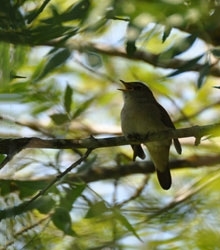Nightingale (Luscinia megarhynchos)
 May is the month to hear the beautiful song of the nightingale. Although the bird itself is not the most striking bird you will ever see, having a brown back, pale underside and a rusty coloured rump, it surely makes up for this dowdiness by its stunning song.
May is the month to hear the beautiful song of the nightingale. Although the bird itself is not the most striking bird you will ever see, having a brown back, pale underside and a rusty coloured rump, it surely makes up for this dowdiness by its stunning song.
Nightingales over-winter in western Africa, returning to our shores in the second half of April when the males will immediately set up a territory and start to sing. They can only be found below a line from Worcestershire in the west to south Yorkshire in the east, as they are at the northern limit of their range. Coppice woodland and scrubby areas with lots of dense undergrowth is the favoured habitat, where the bird skulks around in the new spring growth and is often difficult to see, however the song is loud and nightingales sing throughout the day as well as during the night. I always feel that the song is not at its best when the bird first starts to sing, but improves with practice, reaching its best from mid May onwards. Singing ceases usually in the second week of June once the male has secured a mate and egg-laying has begun.
To stand in a thicket as night falls, listening to a nightingale’s song, is to hear one of the most wonderful sounds on offer in the English countryside. The repertoire consists of up to 200 different song types, often given in slightly different repeated phrases and usually ending in a crescendo. The song is also really loud, carrying long distances on a still night, telling females arriving from Africa that a male is holding a territory and that other males should stay away.
Many people have written poetry and music about the nightingale over the years, but perhaps the cleverest of all occurred in 1924. Beatrice Harrison, the acclaimed cellist, had moved the year before to a house near Oxted in Surrey where she used to practise on her instrument in the garden. She was amazed that whenever she played, a nightingale would join in! She spent some time over the next year convincing the then managing director of the BBC, Lord Reith, to allow a team to come to her Surrey garden the following May to record the two of them playing together. On the 19th May, 1924, the first ever live outside radio broadcast came from her garden at 10:45 in the evening. It was estimated that around a million people tuned in and that 50,000 letters were sent in about the recording. Quite some achievement for a little brown bird!
Peter Thompson
Advisory

Download Peter Thompson's essential 26-page book, featuring beautiful photography and detailed profiles of Britain's wildlife
Download FREE >